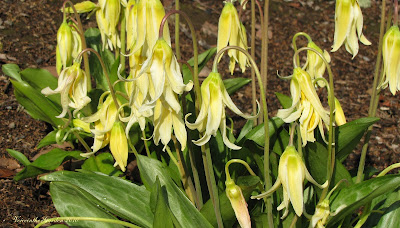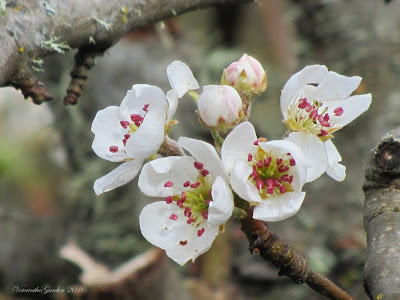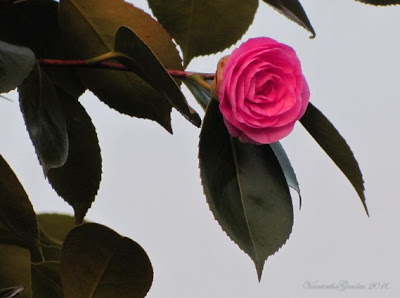Such a busy time of year!
Continued garden cleanup and blossoms to enjoy


while pink plum petals gently mantle the soil's surface.

I chased a butterfly around the garden in an attempt to photograph, but for naught as its elusive behavior took me to the hillside edge.
American Lady, Painted Lady or
West Coast Lady? I do believe it was the latter, but will have to wait for another day to photograph and identify.

Early morning sunrises not to be omitted


prior to assessing outdoor raised vegetable beds and seeds that lay promisingly upon soil blocks in numerous containers strewn about the house.
Shall I ever look upon a chocolate brownie quite the same again?
We finally got our compiled tax information taken to the CPA on Friday, and I'll just say this about that:
nothing, I repeat,
nothing should be that complex and consume such time and energy each year! But for now we can put that aside and get on with real life.

Speaking of vermin, yesterday morning was the third time we found the suet feeder wrapped around the tree branch and the new block of suet completely eaten. Raccoons are likely the culprit, and we had to listen to a flock of Stellar's Jay squawk about what had occurred.
The raccoon may be cute to some, but underneath that mask is a destructive and dangerous animal, a nuisance and one that may carry a communicable disease in their feces; unpalatable is having to clean their excrement from our flower beds all around the house. Currently we replaced the top of our largest bird bath as they often climb into it and repeatedly knock it over - it finally cracked. One of the reasons for giving away the fish in our pond several years ago was that they used it for their feeding ground, and at times we would find a half-eaten fish cast aside. However, most disturbing is to see a raccoon, tail tucked, head bent and occasionally walking through the garden during the day. We even experienced one coming directly toward my husband several years ago.
On the brighter side: around each corner a new blossom peeks its head, fragrance fills the air, bumble bees and honey bees are busy working (and I have some great news on that front another day); birds are singing and scurrying about in preparation, as are we.
 Beans
Beans: Sadie's Horse bean and Bush Blue Lake
Squash: Black Beauty and Straightneck Yellow
Tomatoes: Pineapple and Stupice
These can be found growing in the main garden and raised beds:
Beets: Early Wonder, Ruby Queen, Crapaudine
Broccoli: Packman
Cabbage: Stonehead and Red Acre
Carrots: Purple Dragon and Nantes
Cauliflower: Graffiti and Bishop
Garlic: Chesnok Red purple stripe
Kale: Blue Curled Scotch
Leeks: Giant Musselburgh
Lettuce: Red Fire
Mesclun blend (mild)
Onions:
Texas Sweets and Walla Walla
Peas: Sugar snap
Radish: White Icicle and Sparkler
Spinach: Bloomsdale, Erste Ernte, RegalSwiss chard: Fordhook Giant
Yet elbow deep in seed starting mix and soil blocks,we have the following that have sprouted and appear to be doing well:
Choy Sum,Chinese Kale, andShanghai Bok Choy were seeds sent to us by
Thomas . You will be pleased to know they sprouted within 3 days, except for the latter which popped up in 2!
 Heirloom Tomatoes
Heirloom Tomatoes:
Ashleigh (sprouted in 3 days), Black Krim, Nile River Egyptian, Old German, Pineapple, San Marzano Gigante (the latter not an heirloom)
Basil: '09 seeds have sprouted
Not doing so well are:
Cilantro (used '09 seeds and did not germinate, so I will replant)
Eggplant: Japanese Long Purple (only 4 seeds have germinated)
Kohlrabi: Kongo hybrid (only 1 has sprouted in the peat pot, but some extras I threw into a 4-inch pot are all up and happy. Go figure.)
Lima beans, a bust the second year in a row so I'll discontinue attempting to grow them.
~ ~ ~
Yesterday, the first day of Spring found us doing more work in the garden and cooking, preparing for
D and
J to join us for dinner. This beautiful 68 degree day was celebrated in high fashion: an enjoyable first evening stroll around the garden with good friends and wonderful neighbors and celebrating the beginning of Spring.















 be okay as we covered them over last night and will do so again this evening.
be okay as we covered them over last night and will do so again this evening.




























































